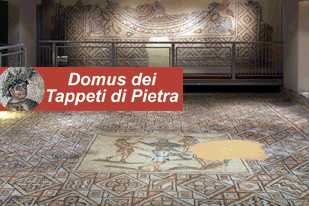Messages and Allegories in Sant' Apollinare in Classe







Messages and Allegories in Sant' Apollinare in Classe. Hotels in Ravenna centre.
We shall now consider the splendid mosaic decorations of the apse of the Basilica of Sant’Apollinare in Classe, Ravenna.
The hand of god extended from heaven.
This was part of the iconographic formula invented under Constantine in order to visually outline the power hierarchy.
For the emperor (who was subsequently replaced by Christ himself or the Madonna) a fixed scheme was developed of a personality seated on the golden throne –once reserved for the gods – the depiction of the imperial majesty remaining unchanged.
This formula was completed by a hand that descended from heaven to bless or crown the emperor for his dignity or triumph.
The hand of god stretched over a person who is on earth (comparable with the scenes on the lunette of San Vitale) which had the same clear iconographic significance as that of majesty.
The theme of the golden throne dates back to the classic era, the hand of God comes from Jewish art: it can be found in the frescoes of the Synagogue of Dura Europos, a century before its use appearance in the Christian imperial art of Constantine.
The sheep and the number 12 .
There are a total of twelve sheep, six on each side, that leave the two cities of Bethlehem and Jerusalem, and a total of twelve sheep alongside the Bishop Apollinare, at the centre of the apse, beneath the large bejewelled cross.
In the Bible the number twelve signifies totality, the whole, completeness: twelve is the number of the tribes of Israel (the populace of Christ) and twelve is also the number of apostles that form the Universal Church.
The sheep signifies a follower of a guide.
The allegory concealed in the figures is clearly apparent: Christ offers salvation to all through his church.
The lush landscape and the two palms at the sides of the apse.
Signifies the joy of salvation in which all of nature participates.
The two palms complete the representation in memory of the Resurrection of Christ.
The allegory of lush and blooming nature, allows the faithful to recognize that Baptism and the Eucharist restores man to Earthly paradise.
The Parrot against a gilt background.
All shades of green used to depict fields, trees and evergreens are blended to form the body of the parrot against a fruit bearing fruit bearing branch which has neither trunk or roots, the only bird to appear in the gilded zone of the apse basin.
The parrot symbolizes Mary, resplendent entrance to Heaven that fills the distance between Christ and all creatures and which permits access to Christ and eternal beatitude.
The green of its feathers cannot be wet by the rain which beats down and dampens the earthly vegetation.
Prof. Gianni Morelli
The pleasure of fine accommodation in the centre of Ravenna: we recommend the Fabbri hotels for a pleasant stay as follows:
The Centrale Byron hotel, 3-star, in the centre of Ravenna, near the monuments;
The Bisanzio Hotel, 4-star hotel in the centre of Ravenna, near the monuments;
Once you have reached the hotel and parked your car, forget it and walk everywhere, because everything is within walking distance.
The railway station is near our hotels and within walking distance of them.
© reserved copyright





